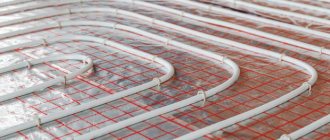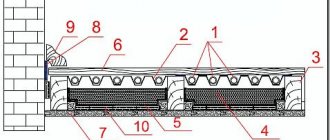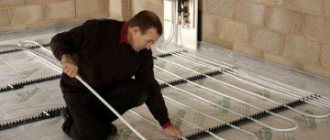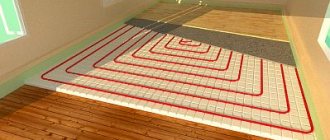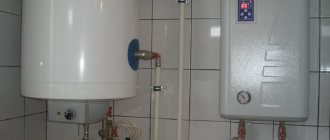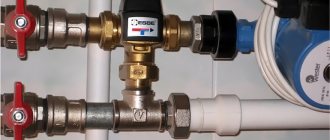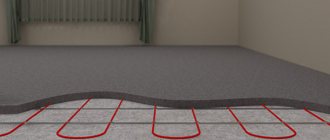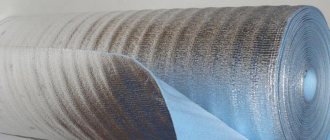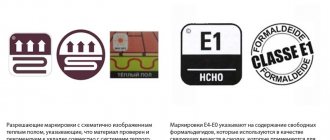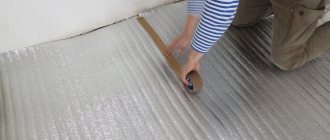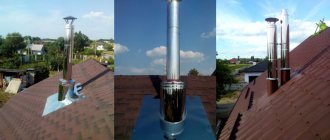Description and characteristics of the material
Adding a layer of foil to already known types of substrate changes their technical characteristics and increases their service life. The main difference is that the foil returns more than 30% of the heat back into the room, and in the case of a foil plug - up to 90%.
The backing for laminate with foil is available from:
- foamed polyethylene;
- polystyrene;
- traffic jams.
Foamed polyethylene
Foamed polyethylene backing is one of the most popular on the market. To improve its technical characteristics, manufacturers began to apply foil to one of its sides. Foiled polyethylene on sale is represented by the brands Izolon, Ecofol, Penofol.
Foaming of the starting material is carried out in two ways - chemical and physical, which is why they have different quality indicators, despite the fact that by name they are the same material.
To produce foamed polyethylene chemically, flame retardants and dyes are introduced into it. As a result of chemical reactions, gas-filled pores isolated from each other are formed in polyethylene. Such polyethylene protects well from noise from neighbors below entering the apartment, and has high vapor permeability and thermal insulation.
A significant disadvantage is its low strength, which is why it quickly shrinks under the laminate. The combination of polyethylene and foil increases the service life of the material, adds waterproofing properties, and significantly enhances the effectiveness of thermal protection due to the reflective properties of the foil. Can operate in temperatures ranging from 40 degrees below zero to 70 degrees above zero.
Foaming of polyethylene by physical means is carried out in special ovens, where pores are formed under the influence of high temperatures. The molecular bond of such a structure is more stable, which affects the performance characteristics of the material - it does not shrink for a long time. Therefore it has a higher price.
Foil polyethylene is produced in the form of rolls with an area of 50 m2, with a thickness of 2 mm to 10 mm (material 4-10 mm thick is used only for insulating walls and ceilings, as well as for installing heated floors).
The cheapest member of the family is “Izolon” made from NPE polyethylene (non-crosslinked polyethylene). Its average price in Russia is 600 rubles per roll. But the performance characteristics of the material - sound and heat insulation properties, durability - are the lowest of all types of substrates.
The material made of cross-linked polyethylene (PPE) has high rigidity and strength, with good elongation resistance, and does not lose its qualities for 25 years. Such substrates during operation are capable of performing at the same level as expensive substrates. In accordance with the quality, the price of “Isolon” made of PPE polyethylene starts from 29 rubles/m2 (1,450 rubles per roll).
Experts note one feature: the lining under the laminate made of 4 mm thick NPE polyethylene has absolutely identical quality indicators to the 2 mm PPE backing, but the latter has a much longer service life.
Polystyrene
The polystyrene foil backing consists of foil and foam glued together - polystyrene foamed under the influence of high temperatures. The material has a fine-porous structure. Available in slab form. It has:
- sound absorption - 23 dB;
- impact strength (dynamic) - 30 mg/m3;
- low thermal conductivity - 0.035 W/m2;
- bending strength - 0.25 MPa;
- compressive strength - 0.16 MPa.
The given indicators allow us to draw the following conclusions:
- under static and dynamic loads the substrate does not lose elasticity;
- absorbs noise well;
- is a good insulator.
Adding a layer of foil not only improves the above characteristics, but also adds a new property - waterproofing, which is important in rooms with high humidity or the risk of water spilling on the floor. The price of such material is quite high - from 90 rubles. per stove.
For information: professional builders consider foam and polystyrene to be different materials, which often leads to confusion. Polystyrene foam is any foamed plastic, polystyrene is one of the types of foam plastic.
Cork
Cork backing has many advantages:
- durable;
- durable;
- environmentally friendly;
- good insulation;
- has a high level of sound absorption;
- completely eliminates the errors of the concrete screed.
At the same time, there are significant disadvantages:
- cannot be installed in damp areas;
- requires mandatory waterproofing;
- collapses under prolonged static pressure (under heavy furniture).
Adding a layer of foil to the substrate eliminates these disadvantages. The only negative remains - the high price. For example, a 2 mm substrate can be purchased from 180 rubles/m2, 3 mm thick - from 250 rubles/m2.
Main characteristics of insulation
There are several types of penofol available for sale:
- Class A. Has a foil surface on one side. Can be used for thermal insulation of wall surfaces, floor coverings, and insulation of communications.
- Class B. Foiling is done on both sides of the material. Area of application: thermal insulation of partitions between rooms and ceilings between floors.
- Class C. Has foil on one side only. The other is coated with a self-adhesive compound and film, which protects the material from sticking together inside the roll.
- Super class - NET. It is used for insulation of communication networks, pipelines, production equipment, and also as a sound insulator in automotive production.
- ALP class. A thin film of polyethylene is applied to the surface. It is used mainly in agriculture for the purpose of thermal insulation of commercial buildings.
- Class M - R. One of the sides contains foil, the other is distinguished by its relief.
The most common types of penofol are types A, B and C. They are also most often used for floor insulation.
- These varieties have approximately equal operating temperature ranges, ranging from -60 to +100 degrees Celsius.
- Thermal reflectance ranges from 95 to 97%.
- The mass of one cubic meter of type A penofol is 44 kg. B - 54 kg, C - 74 kg.
- The level of moisture resistance when the material is soaked in water is 0.7% for type A, 0.6% for type B and 0.35% for type C.
- The vapor permeability index of all varieties is no more than 0.001 mg/mchPa.
Pros and cons of foil backing
Adding a foil layer to traditional types of substrate improves the quality characteristics of the material:
- durability increases (firmness and elasticity lasts longer);
- sound absorption increases;
- thermal insulation increases;
- Improves protection against mold, insects and mice.
At the same time, new qualitative characteristics appear:
- The ability of the substrate to reflect heat back into the room. Studies show that the reflective ability of foil to return heat to the apartment reaches 90% in some cases (the minimum value of the indicator is 30%);
- Properties of vapor and waterproofing.
The disadvantage for a substrate made of NPE polyethylene is a short service life, for other types of foil substrate it is a high price. However, this cost of foil pads is justified by the high quality of the product.
Possessing new properties, a substrate with foil becomes indispensable when installing heated floors and laminate flooring in wet rooms, for example, in the kitchen (in the bathroom and toilet, ceramic tiles are usually laid on the floor). Its use in dry rooms is not financially justified, since here the problem of heat conservation can be solved by other, cheaper methods.
Area of use of foil insulation
There are many places in the room that need insulation, this is not only a layer of insulation of the main walls. And since the products are affordable, everyone can implement thermal insulation.
Insulation of balconies and loggias
For this purpose, insulation with polyethylene (penofol) is most often used. Maximum thickness – 10 mm. The surface of the foil is selected smooth or corrugated. If you live in a region with a cold climate, such a thin layer will not be enough for complete insulation. Ideally, isover insulation is supplemented with ordinary mineral wool or polystyrene foam.
Advice! It is better to use polystyrene foam. It is not only cheaper, but also not afraid of moisture (unlike cotton wool). And the balcony is a damp place. The slabs are fixed using foam adhesive.
Insulation scheme:
- Preparing the base, cleaning, removing old coating, if any.
- Fixing polystyrene foam with adhesive foam. You can use another option - creating a wooden frame and laying polystyrene foam in the cells.
- Foiled penofol is glued on top of the foam.
- Installation of wooden or metal sheathing to create a ventilation gap and a backing for finishing material.
- The finishing can be siding, lining, plastic panels, block house, drywall.
The foil layer cannot be laid overlapping. Everything is done end-to-end and taped with special aluminum tape.
Pipe insulation
Foil pipe insulation is used for pipelines, communications underground or outside. The process is very easy and does not require a professional approach. You need to buy insulation of the required diameter, put it on the required place, removing the film from the adhesive layer. Thanks to the outer foil layer, the pipes will be protected from heating. And if the foil is on the inside, then the heat will be transferred back into the pipe.
Mineral wool is used as insulation if the pipes are located outside, sometimes it is foil penofol.
Bath insulation
Rolled materials are suitable for this purpose. They are easier to work with. Foamed polyfol or mineral wool of medium thickness is suitable. Installation of insulation begins from the ceiling, then the walls are insulated, and then the floor is treated. In addition to mineral wool, it is important to buy parchment, it is fixed to the ceiling.
The insulation scheme is as follows:
- A wooden sheathing is created. The insulation is placed there with glue.
- If the insulation layer is torn during installation, this can be repaired with aluminum tape.
- A counter-lattice is fixed to the sheathing for finishing and creating a ventilation gap.
- All that's left is the finishing touches.
External insulation
It is better to carry out thermal insulation work outside. But when this cannot be done, it is permissible to insulate the house inside. Foil mineral wool of medium thickness is used. To work you need glue, a construction gun, dowels, and windproof film.
The thermal insulation process is as follows:
- The starting strip is fixed with dowels around the perimeter. The first layer of mineral wool will rest on it.
- Glue is applied to the inside of the insulation and pressed against the wall. For better fixation, you can use plastic dowels with an umbrella.
- A wind barrier is mounted on top of the made layer.
- At the end there is a finishing touch.
Roof insulation
It is best to buy basalt foil slabs for the roof. Insulation is performed as follows:
- All cracks and crevices on the roof are sealed. Tow or polyurethane foam is suitable for this.
- A vapor barrier layer is created. It is enough to buy glassine fixed to a stapler. (see - Vapor barrier material)
- Then the formwork is done and everything is done according to the standard scheme: laying basalt wool and finishing.
If everything is done correctly, the house will be warm and cozy. Foil insulation is a good solution for thermal insulation. It has many advantages, and most importantly, it can be used to finish pipes and places with bends. The aluminum layer protects the insulation from negative influences, extending the service life of the insulating layer.
How to style
When faced with an unusual underlay, many buyers do not know how to put the underlay under foil laminate flooring. They also don’t have an answer to the question of which side to put the foil backing on. Foamed polyethylene is cut to size and left rolled out for a day.
Then the first sheet is laid, with the obligatory approach to the walls at the points of contact. The height of the overlap is 5-10 cm (if the substrate is visible above the floor, it is carefully cut off with a construction knife and covered with a plinth). Be sure to lay the foil side up.
Since it is strictly forbidden to walk on the foil, the laminate is installed on the laid sheet. Then the second sheet is rolled out, touching the walls at the beginning and end, and end-to-end with the first sheet. The seam is glued with a special metallized tape.
The sheet substrate is laid in the same way as brickwork is laid - the connecting seams should not coincide. Wall climbing is not allowed. The sheets are laid close to each other. The seams are sealed. Just as with polyethylene underlayment, a row of underlayment is laid down and slats are placed on top of it.
During work the following must not be allowed:
- coincidence of the seams of the substrate with the locks of the laminate;
- creasing of material when applying to the wall;
- gaps between laid canvases or substrate slabs;
- gluing metallized tape together.
In addition to laminate, such a substrate is also used for linoleum. And here many novice builders have the desire to make a sandwich: floor base-foil backing-chipboard-linoleum. They are driven by the desire to provide water and sound insulation, as well as dampen floor vibration when walking.
So how to put a backing with foil under the chipboard? No way. If the subfloor is wooden, then when attaching the chipboard to the base with self-tapping screws, the foil will be torn, and the point of laying such a substrate is lost.
On a concrete base, chipboard falls between two layers that do not allow steam to pass through: foil on the bottom, linoleum rubber on top, which is extremely undesirable. Practice shows that chipboard very often swells in such a situation.
There is another problem here: chipboard raises the floor, which does not always match the floor level in other rooms. Here it is better not to use additional layers of material at all, but to put a backing on the screed, and linoleum on top of it.
The foil backing for linoleum does not lie under the chipboard, but on the chipboard. In this case, it performs all the functions that are inherent in this type of material (details about the functions of the substrate can be found in the work “Which substrate to choose for laminate”).
For reference: if instead of chipboard you have to install plywood, then everything said for the first material also applies to it.
Scope of application of penofol
Even when used in a private home, this material can be used quite widely. Let's study the list of main directions.
Insulating a wooden floor with your own hands
Penofol is quite often used for insulating floors in wooden buildings. The process is as simple as possible, and it is quite possible to do it yourself. You just need to strictly follow a simple algorithm:
- Dismantle the old plank floor covering and lay penofol in the space between the joists in several layers. Each layer should be laid with the foil side inside the room. After this, you can mount the old boards in place or lay down the plywood sheets.
- In another case, you can lay the insulation directly on top of the wooden base. Then the insulation is laid in one layer, the material fragments are placed end to end. The seams are sealed using aluminum-based tape. Plywood is laid on top of the equipped thermal insulation layer. It is attached to the wooden base of the floor with self-tapping screws.
What thickness to choose
The optimal thickness of any substrate is 3 mm. It allows you to level out screed errors of up to 1 mm. A 2 mm cork substrate will also cope with this task, due to its high density and elasticity.
If the height of the floor screed differs by 1-2 mm, a substrate 4 mm thick will be required, 2-3 mm - 5 mm thick. For more significant floor unevenness, the problem must be solved using a self-leveling mixture.
The appearance on sale of substrates with foil is caused primarily by the appearance of heated floors. When laying laminate flooring, they allow you to better retain heat in the apartment and protect the substrate from high humidity in the room.
